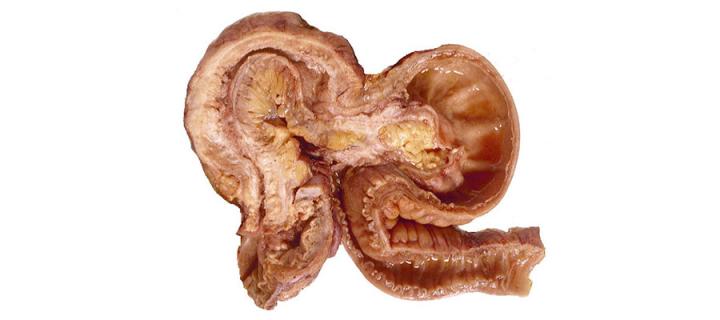Human Gut Cell Atlas – Normal Intestine and Crohn’s Disease
Edinburgh researchers receive support from the Helmsley Charitable Trust to provide new insights into Crohn’s disease: November 2019

Crohn's disease is a type of inflammatory bowel disease (IBD) affecting up to 0.8% of the population worldwide. It causes inflammation of the digestive tract, which can lead to abdominal pain, severe diarrhoea, fatigue, weight loss and malnutrition. It is also associated with an increased risk of intestinal cancer. Inflammation caused by Crohn's disease can involve different areas of the digestive tract in different people and genetic studies have identified over 200 regions in the DNA where genes can increase susceptibility to it. Unfortunately, Crohn’s disease is still incurable and the mechanisms involved in its development and progression remain elusive. Therefore, there is a pressing need to better understand the mechanisms of Crohn’s disease at the molecular level.
A team of investigators led by Professor Mark Arends from the Edinburgh Cancer Research Centre and Centre for Comparative Pathology (University of Edinburgh), Dr Shahida Din (Lothian Health Board), Professors Richard Baldock and Albert Burger (Heriot-Watt University), Dr David Adams (Wellcome Trust Sanger Institute) and Dr Irene Papatheodorou (European Bioinformatics Institute) have been awarded $2.5 million by the Helmsley Charitable Trust – a highly respected US-based charity supporting exceptional efforts in health and select place-based initiatives – to conduct a project looking at normal intestinal tissue and tissue from people with Crohn’s disease. This project will contribute to the Gut Cell Atlas, funded by Helmsley.
The Gut Cell Atlas aims to catalogue the many cell types in the small and large intestines. As part of this larger effort, the main goal of the Arends-led project is to provide an integrated dataset of single cell RNA sequence data mapped onto a high-resolution 2-dimensional and 3-dimensional atlas of digital histological images from both normal intestines and those with Crohn’s disease, focusing on the terminal ileum and ascending colon. This spatially-organised platform will allow interrogation of location and disease-specific transcriptomic data providing novel insights into Crohn’s disease pathogenesis and progression, crucial to developing new personalised therapeutic strategies. Importantly, all protocols and software created during the project will be fully open access/open source.
We are grateful to the Helmsley Charitable Trust for their support and very thrilled to undertake this exciting project to develop and catalogue an atlas model of intestines systematically characterizing differences in cell-type abundances and gene expression between normal intestine and Crohn’s disease. We very much hope that the dataset that we will develop will lead to better therapies in the future
Related Links
Professor Mark Arends group website: https://www.ed.ac.uk/cancer-centre/research/arends-group
Centre for Comparative Pathology website: https://www.ed.ac.uk/comparative-pathology/our-research/cancer
The Helmsley Charitable Trust website: https://helmsleytrust.org/
Original press release by The Helmsley Trust: https://helmsleytrust.org/news/scientists-create-%E2%80%9Cgut-cell-atlas%E2%80%9D-funding-helmsley-charitable-trust
More information about Crohn’s disease: https://www.crohnsandcolitis.org.uk/about-inflammatory-bowel-disease/crohns-disease
What is RNA? https://www.rnasociety.org/about/what-is-rna/
More information about single cell RNA sequencing: https://www.nature.com/articles/s12276-018-0071-8

